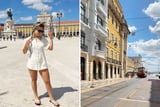My first-ever trip to Portugal was confirmation that the southern European country is just as artsy, charming, and culturally captivating as they say. While I only got to visit Lisbon, Porto, and Cascais during my stay, I still experienced plenty of the hype, from the jaw-dropping architecture that dates back to the 1500s (don’t miss the Jerónimos Monastery and Castelo de São Jorge!) to the beautiful sand beaches and traditional cuisine.
One perk I noticed almost immediately? Portugal happens to be relatively affordable when compared to other parts of Western Europe I’ve visited, which is all the more reason to embark on a romantic wine tour as you walk along the cobblestone streets and allow yourself to be completely enamored by the tiled facades and vibrant artwork (look out for Portuguese street artist Bordalo II’s animal installations made from recycled trash – my personal favorite).
The good news is there’s something for everyone, whether you enjoy exploring medieval old towns or romping on the beach. Just remember to take a note from my packing list after the jump, so you’re fully prepared for whatever the day brings and can carry out a proper vacation post-mortem when you return.
Where to Stay in Portugal
On my trip to Portugal, I spent time in Porto, Lisbon, and Cascais, and had incredible experiences in all three cities. I stayed at
In Lisbon, I stayed at the
While I didn’t stay overnight in Cascais, my sister loved
What and Where to Eat in Portugal
Your first to-do from a food perspective is to grab a Pastel de Nata, the traditional Portuguese egg custard tart you’ll see everywhere you go. You should then proceed to sample as many as possible, comparing features of each. Some are served cold, while others are warm and dusted with cinnamon. Baked in a crisp puff pastry shell, the creamy custard filling is almost always slightly blackened on top, offering a heavenly bite of sweet lemon. Sardines are also a popular snack (more on that below), and you’ll often find them on the menu, along with salted cod.
My personal favorite restaurants were in Lisbon, where the food scene seems to be top notch – from Zazah, where I enjoyed the best corn cream ravioli I’ve ever had in my life, to Bonança, which is tied to the Associação Naval de Lisboa – the oldest sport club of Portugal that sits in plain view of the Monument of the Discoveries on the Tagus River. And if you’re a wine lover, there’s lots to explore in Douro Valley.
Ahead, check out my complete packing guide for Portugal. Armed with these tips and packing hacks, you’ll be more than ready to book a flight.




